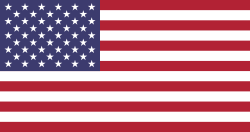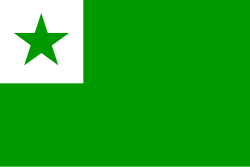Top Qs
Timeline
Chat
Perspective
Flag icons for languages
Using national flags as icons for languages From Wikipedia, the free encyclopedia
Remove ads
The use of flag icons, particularly national flags, for languages is a common practice. Such icons have long been used on tourist attraction signage, and elsewhere in the tourism space, but have found wider use in website localization where UX limitations have become apparent.[1][2]

The usage remains widespread despite problems, such as being potentially insulting, since countries and languages don't have a one-to-one correspondence. The World Wide Web Consortium suggests not using such practice, and recommends using texts instead.[3][4]
Remove ads
Types of flags icons
Summarize
Perspective
National flags
National flags are the most commonly used flag icons for representing languages. They are generally chosen because they either represent the language's origin (e.g. the flag of Spain used over the flag of Mexico) or the highest number of native speakers (e.g. the flag of the United States over the Flag of England).
- The flag of Spain is often used to represent Spanish, despite having fewer native speakers than Mexico
- The flag of United States is often used to represent English, despite not being its origin
Mixed national flags
A diagonally divided flag between two or more nation states are sometimes used when more than one country is a major user of a language. Examples of this are the flags of the United Kingdom, the United States and Canada to indicate the English language, the flags of China and Taiwan to represent Mandarin, the flags of France, Belgium, and Canada to represent the French language, the flags of Spain and Mexico to represent the Spanish language, and the flags of Portugal and Brazil to represent the Portuguese language.[5][6]
Linguistic flags
Some international linguistic communities have flags which encompass all the speakers of a language while avoiding the symbolism of national flags, though they are not as widely recognized.[7]
- The flag of the International Organisation of La Francophonie, representing French
- The flag of the Community of Portuguese Language Countries, representing Portuguese
- The Verda Stelo flag, representing Esperanto
Remove ads
Writing systems
National flags can also be used to distinguish between different written standards for a single language. For example, the Flag of Taiwan is often used for Traditional Chinese and the Flag of the People's Republic of China for Simplified Chinese.[8]
- Flag of Taiwan, representing Traditional Chinese
- Flag of China, representing Simplified Chinese
Political motivations

Some Euronet ATMs (automated teller machines) display the Irish flag as a symbol for the English language (usually UK flag or English flag). This was speculated to be a response to Brexit, with the Republic of Ireland as one of the only two remaining European Union member nations (along with Malta) with English among their official languages. The Irish flag is more commonly used to signify the Irish language.[9]
Gallery
- Sign in San Francisco, Córdoba, Argentina; unusually, the Spanish language is indicated by an Argentine flag, while below it is Italian and Piedmontese text with the flags of Italy and Flag of Piedmont.
References
External links
Wikiwand - on
Seamless Wikipedia browsing. On steroids.
Remove ads















